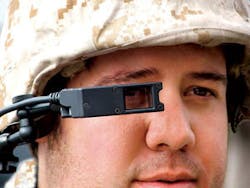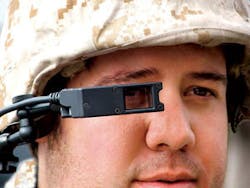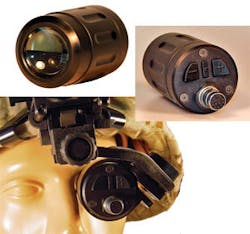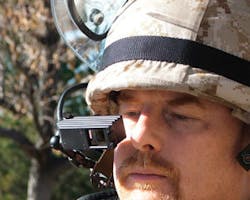Department of Defense invests in delivering augmented reality technology to foot soldiers
By Courtney E. Howard
SAN DIEGO - The Center for Commercialization of Advanced Technology (CCAT) in San Diego has invested Department of Defense (DOD) money in head-mounted displays (HMDs) that deliver augmented reality to military and homeland security forces.
CCAT is a public-private collaborative partnership between academia, industry, and government that is supported by Congress, and funded by the DOD. CCAT personnel are tasked with seeking out innovative technologies that address needs deemed priorities by the DOD and the Department of Homeland Security (DHS), and then helping guide them through the technology-transfer process and into the hands of warfighters, first responders, and homeland security personnel.
CCAT provided Liteye Systems Inc. of Centennial, Colo., with a market study and a $75,000 product development award to support the improvement of its HMD’s optics.
Tom Scott and Kenneth Geyer founded Liteye in January 2000 to develop a solution for the Pensacola Naval Air Station in Florida, their first customer. The station’s helicopter crewmen needed to download computer data and graphics from thermal cameras; lacking sufficient space in the helicopter for a traditional monitor, they required an HMD, which Liteye delivered.
Liteye’s HMDs combine a small, over-the-eye monitor mounted to an adjustable band worn around the head or helmet. The company’s HMDs built for military usage are engineered to withstand rugged conditions, including extreme climates, precipitation, and dust. The LE-600 HMD, for example, can be submerged for a maximum of eight hours in water 60-feet deep.
Liteye’s HMD departs from a traditional monitor in that it offers augmented reality, meaning the transmitted data displays transparently so that the user can see through the image. “The image is laid over your view of the real world,” Geyer explains. “Picture your Windows desktop floating around in space, but instead of staring at a monitor, you’re looking through an optic that projects that picture over your view.”
Augmented-reality HMD technology can play an important role on today’s digital battlefield. “Non-see-through displays inhibit a soldier’s view and are always something to deal with,” Geyer continues. “You could picture the soldier staring out on the battlefield through his see-through HMD and having the enemy positions highlighted in red. Just like in a video game, but in the real world. Having his threats laid out this way would give him a major advantage.”
Liteye staff used the CCAT money to engineer a lightweight plastic lens that offers image color correction and image clarity comparable to glass lenses. “We were able to maintain the advantages of a glass prism optic, but we were able to do it in plastic which has never been done,” Geyer says. “It brought the weight down, but we can still sustain the distortion-free aspects of the additional color correction.” Liteye management anticipates bringing the plastic optic to market in the fall.
While the new plastic optics are under development, Liteye continues delivering glass-lens HMD technology to military customers, which include the U.S. Army, U.S. Navy, German Army, Japanese Self-Defense Forces, and the British Future Integrated Soldier Technology (FIST) program. U.S. Navy personnel use the Liteye systems to view schematics during equipment repair, maintenance, and medical triage applications, as do members of the U.S. Army, who also uses HMDs for command and control applications.
“It seems like everyday, someone tells us about how the systems are being used for a different program in which a smaller display is required,” says Geyer.
“We had multiple military customers who needed a reliable full-color video HMD in the field,” Rob Lund, lead engineer on the development of the company’s new LE-625 HMD, notes.
The LE-625 HMD system, now shipping to customers in the U.S. and Europe, was built to meet customer demands for color video in a rugged package. It features a 640x480-resolution, full-color LCD, support for NTSC and PAL inputs, and MIL-SPEC design qualities identical to its LE-600 predecessor.
Liteye engineers are currently developing a system for NASA in which the display is attached to the bottom of the face shield in a space helmet. Astronauts need only glance down to view data and images. This same technology has also been developed for use in face shields of bomb disposal crews. Geyer, unsure as to when HMDs would go into the stratosphere, expects testing to conclude by the end of 2007.



